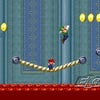Saturday Soapbox: Why the 3DS Won't Die
Why Nintendo never Bowser under pressure.
But why now? Why couldn't Nintendo get it right before launch? Hindsight is a useful thing, but it is worth remembering how the 3DS was announced - to a roaring press reaction at E3 2010. Lines snaked across the show floor for enthusiastic journalists to lay hands on the new hardware. The 3DS encompassed the million-selling pedigree of the DS and the contemporary coolness of 3D, a technology that had piqued public interest with the likes of Avatar, the roll out of 3D TVs and major broadcasters apparently on the brink of making 3D programming mainstream. The most successful company in handheld gaming had seemingly done it again.
But, a year later, it turns out no one wants Avatar 2. We're still not used to watching 3D sport wearing ridiculous glasses in the pub. No one cares about 3D anymore.
Yes, it would be a mistake to launch the 3DS with such a strong emphasis on 3D now, but twelve months ago press and public alike were still apparently enamoured. Few would have predicted the device's troubled launch or the tabloid fearmongering over the system's 3D capabilities.
Nintendo should be praised for reacting to the current climate. Company boss Satoru Iwata effectively putting his own job on the line should the 3DS not fare better shows how seriously the handheld's fate is being taken. Likewise the device's recent price cut is unprecedented for Nintendo in both speed and scope.
Nintendo's main marketing hook may have gone out of fashion, but the company has already clearly adapted. By labelling the device as a next-generation successor to the DS, Nintendo is pushing some of the same notions that won the public over with the DS. While the gimmick of a second screen was often underused by DS games (how many actually used it for anything more than a map or inventory?) its ability to be used for touch screen input marked it out from the GBA.
With its 3D functions pushed to the back burner, the 3DS lacks another similarly game-changing feature, but if the public is shown just how much better games can look on the device, Nintendo still has a chance to convince gamers the device is worth the upgrade.
Then of course, it has its games. Of the twelve best-selling DS titles, four star Mario and four feature Pokemon (seven if you count Diamond/Pearl, HeartGold/Soul Silver and Black/White individually). This year sees Super Mario 3D Land and Mario Kart 3D notch up the plumber's first and second 3DS appearances, while Pokemon spin-off Rumble Blast also arrives before the year is out.
Nintendo gambled a weaker launch line-up against a healthy head start on PlayStation Vita, presumably hoping the allure of 3D gaming would paper over an undeniably weak initial roster. But while Nintendo's core franchises were unforgivably absent from the system's launch, the launch of Zelda: Ocarina of Time 3D showed the percentage of 3DS players hungry for quality 3DS games and not put off by non-iOS pricing: over 20 per cent of the system's UK userbase bought the re-released classic within its first two days.
Nintendo will sell hardware when its big-hitting games arrive, and it'll sell even more as it hones its marketing machine and product designs. So it was with the DS, so it will be with the 3DS.
Should the company give up its hardware aspirations and wave a Sega-white flag as if it was 2001? Should the 3DS be scared into an early cancellation like poor Joey Tribbiani? Of course not. Yes, the house of Mario has a fight on its hands. But it's seen it all before. And whatever its track record on Italian-American stereotypes, I like to think that if Nintendo had produced Joey, Matt le Blanc would have gotten another chance.















